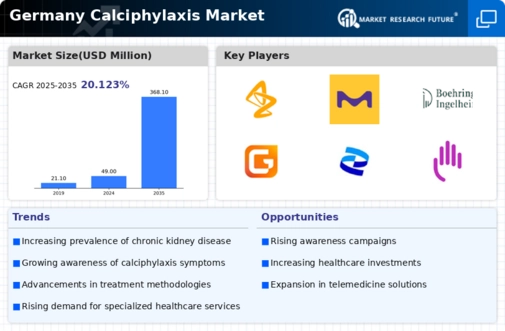Emerging Research and Clinical Trials
Ongoing research and clinical trials focusing on calciphylaxis are significantly impacting the calciphylaxis market in Germany. Innovative studies are exploring novel therapeutic approaches, including the use of bisphosphonates and sodium thiosulfate, which have shown promise in managing calciphylaxis symptoms. The German healthcare system has seen an increase in funding for such research, with an estimated €50 million allocated for nephrology-related studies in 2025. This investment not only enhances treatment options but also raises awareness among healthcare professionals, potentially leading to earlier diagnosis and intervention in calciphylaxis cases.
Advancements in Diagnostic Technologies
Technological advancements in diagnostic tools are playing a pivotal role in shaping the calciphylaxis market in Germany. Enhanced imaging techniques and biomarker identification are facilitating earlier and more accurate diagnoses of calciphylaxis. For instance, the use of high-resolution ultrasound and skin biopsy techniques has improved the detection rates of this condition. As diagnostic capabilities expand, healthcare providers are likely to identify calciphylaxis cases more effectively, leading to timely interventions. This trend is expected to drive the demand for related treatment options, thereby positively impacting the overall market landscape.
Healthcare Policy and Reimbursement Changes
Recent changes in healthcare policies and reimbursement frameworks in Germany are likely to influence the calciphylaxis market. The introduction of new reimbursement codes for calciphylaxis treatments may facilitate better access to necessary therapies for patients. Additionally, the German Federal Joint Committee (G-BA) has been actively reviewing treatment protocols, which could lead to improved guidelines for managing calciphylaxis. As reimbursement becomes more favorable, healthcare providers may be more inclined to adopt advanced treatment modalities, thereby expanding the market for calciphylaxis management.
Increasing Incidence of Chronic Kidney Disease
The rising prevalence of chronic kidney disease (CKD) in Germany is a critical driver for the calciphylaxis market. As CKD progresses, patients often develop secondary hyperparathyroidism, which can lead to calciphylaxis. Recent studies indicate that approximately 10-15% of patients with end-stage renal disease may experience this condition. This growing patient population necessitates enhanced awareness and treatment options, thereby propelling the calciphylaxis market. Furthermore, the aging population in Germany, which is projected to reach 22% by 2030, is likely to exacerbate the incidence of CKD, further influencing the demand for calciphylaxis management solutions.
Growing Demand for Specialized Healthcare Services
The increasing demand for specialized healthcare services in Germany is a notable driver for the calciphylaxis market. Patients with complex conditions, such as calciphylaxis, often require multidisciplinary care involving nephrologists, dermatologists, and pain management specialists. This trend is reflected in the establishment of specialized clinics and treatment centers dedicated to managing rare diseases. The German healthcare system is adapting to this demand, with an estimated 30% increase in specialized care facilities over the past five years. This shift not only enhances patient outcomes but also stimulates market growth by creating a focused environment for calciphylaxis treatment.

















Leave a Comment